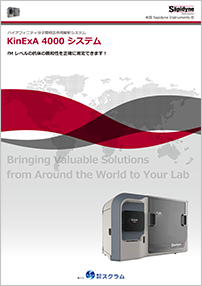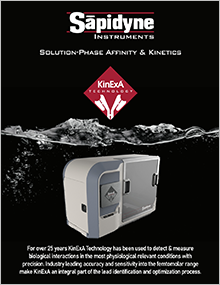資料ダウンロード ハイアフィニティ分子間相互作用解析装置 KinExA 4000

KinExA シリーズ:資料ダウンロード
ハイアフィニティ分子間相互作用解析システム KinExAシリーズのカタログ等の資料ダウンロードページです。
マニュアルやHow To Guidesは ユーザーサポートページをご覧ください。
カタログ
ホワイトペーパー
テクノロジーノート
- TN200 Receptor Valency Effects in KinExA Measurements(英語)
- TN203 Determining Dilution Series(英語)
- TN204 Material Usage(英語)
- TN205 Drift Correction Analysis(英語)
- TN206 Minimum Sample Volumes(英語)
- TN208 Dye Photobleaching(英語)
- TN209 KinExA Pro Software Shortcuts(英語)
- TN210 Titrant Related NSB(英語)
- TN211 Whole Cell Assay(英語)
- TN213 Cooperativity(英語)
- TN214 KinExA Pressure Data(英語)
- TN215 Effect of Sample Dilution Method on Incubation Time(英語)
- TN216 Baseline Creep(英語)
- TN218 Concentration Immunoassays(英語)
- TN219 Reducing Non Specific Binding(英語)
- TN220 Theory Curve(英語)
- TN221 KinExA Mode(英語)
- TN222 Solid Phase Selection Guide(英語)
- TN223 Labeling Strategies(英語)
- TN224 Linear Range(英語)
- TN225 Increasing the Signal(英語)
- TN226 Reusing Beads(英語)
- TN228 Signal Versus Signal to Noise(英語)
- TN229 KinExA Analysis(英語)
- TN234 KinExA vs SPR(英語)
ニュースレター
Sapidyne Instruments社が毎年発刊しているニュースレターです。KinExAに関する様々な有用な情報が掲載されています。
- 2022 NewsLetter(英語)
- 2021 NewsLetter(英語)
- 2020 NewsLetter(英語)
- 2019 NewsLetter(英語)
- 2018 NewsLetter(英語)
- 2017 NewsLetter(英語)
- 2016 NewsLetter(英語)
- 2015 NewsLetter(英語)
- 2014 NewsLetter(英語)
- 2013 NewsLetter(英語)
- 2012 NewsLetter(英語)
参照論文
Affinity & Kinetic Measurements:
KinExA technology overview:
-
Wani T.A., et al. 2016.
New analytical application of antibody-based biosensor in estimation of thyroid-stimulating hormone in serum.
Bioanalysis 10.4155/bio-2015-0034. https://www.ncbi.nlm.nih.gov/pubmed/26978548
-
Glass T.R., Winzor D.J. 2014.
Confirmation of the validity of the current characterization of immunochemical reactions by kinetic exclusion assay.
Anal Biochem 456: 38-42. http://www.ncbi.nlm.nih.gov/pubmed/24751468
-
Bee C., et al. 2012.
Exploring the dynamic range of the kinetic exclusion assay in characterizing antigen-antibody interactions.
PLOS ONE 7(4): e36261. http://www.ncbi.nlm.nih.gov/pubmed/22558410
-
Darling R.J. and Brault P.A. 2004.
Kinetic exclusion assay technology: characterization of molecular interactions.
Assay and Drug Dev Tech 2(6): 647-657. http://www.ncbi.nlm.nih.gov/pubmed/15674023
KinExA’s role in drug discovery:
-
Danial M, et al. 2017.
Site-Specific Polymer Attachment to HR2 Peptide Fusion Inhibitors against HIV-1 Decreases Binding Association Rates and Dissociation Rates Rather Than Binding Affinity.
Bioconjug Chem. 10.1021/acs.bioconjchem.6b00540. https://www.ncbi.nlm.nih.gov/pubmed/?term=10.1021%2Facs.bioconjchem.6b00540
-
Kariolis MS, et al. 2017.
Inhibition of the GAS6/AXL pathway augments the efficacy of chemotherapies.
J Clin Invest. 10.1172/JCI85610. https://www.ncbi.nlm.nih.gov/pubmed/?term=10.1172%2FJCI85610
-
Fan Y., et al. 2016.
Immunological Characterization and Neutralizing Ability of Monoclonal Antibodies Directed Against Botulinum Neurotoxin Type H.
The Journal of Infectious Diseases 15;213(10):1606-14. https://www.ncbi.nlm.nih.gov/pubmed/26936913
-
Köck, K., et al. 2015.
Preclinical development of AMG 139, a human antibody specifically targeting IL-23.
British Journal of Pharmacology 172:159-172. http://www.ncbi.nlm.nih.gov/pubmed/25205227
-
Tabrizi M.A., et al. 2009.
Translational strategies for development of monoclonal antibodies from discovery to the clinic.
Drug Discov Today 14(5/6): 298-305. http://www.ncbi.nlm.nih.gov/pubmed/19152840
Significance of “solution phase” measurements to unmodified molecules:
-
Tigue NJ, et al. 2017.
MEDI1873, a potent, stabilized hexameric agonist of human GITR with regulatory T-cell targeting potential.
Oncoimmunology.10.1080/2162402X.2017.1280645. https://www.ncbi.nlm.nih.gov/pubmed/?term=10.1080%2F2162402X.2017.1280645
-
Kusano-Arai 0., et al. 2016.
Kinetic exclusion assay of monoclonal antibody affinity to the membrane protein Roundabout 1 displayed on baculovirus.
Anal Biochem.10.1016/j.ab.2016.04.004. https://www.ncbi.nlm.nih.gov/pubmed/27095060
-
Blake R.C., Li X., Blake D.A. 2007.
Covalent and noncovalent modifications induce allosteric binding behavior in a monoclonal antibody.
Biochemistry 46: 1573-1586. http://www.ncbi.nlm.nih.gov/pubmed/17279622
Comparison to SPR:
-
Fleming JK, Wojciak JM. 2017.
Measuring Sphingosine-1-Phosphate: Protein Interactions with the Kinetic Exclusion Assay.
Methods Mol Biol. 10.1007/7651_2017_5. https://www.ncbi.nlm.nih.gov/pubmed/28349502
-
Abdiche YN. et al. 2016.
Assessing kinetic and epitopic diversity across orthogonal monoclonal antibody generation platforms.
MAbs. 10.1080/19420862.2015.1118596. https://www.ncbi.nlm.nih.gov/pubmed/?term=10.1080%2F19420862.2015.1118596
-
Kusano-Arai 0., et al. 2016.
Kinetic exclusion assay of monoclonal antibody affinity to the membrane protein Roundabout 1 displayed on baculovirus.
Anal Biochem.10.1016/j.ab.2016.04.004. https://www.ncbi.nlm.nih.gov/pubmed/27095060
-
Drake A.W., et al. 2012.
Biacore surface matrix effects on the binding kinetics and affinity of an antigen/antibody complex.
Anal Biochem. 429(1):58-69. http://www.ncbi.nlm.nih.gov/pubmed/22766435
Sensitivity to measure tight binders:
-
Abdiche YN. et al. 2016.
Assessing kinetic and epitopic diversity across orthogonal monoclonal antibody generation platforms.
MAbs. 10.1080/19420862.2015.1118596. https://www.ncbi.nlm.nih.gov/pubmed/?term=10.1080%2F19420862.2015.1118596
-
Owyang A.M., et al. 2011.
XOMA 052, a potent, high-affinity monoclonal antibody for the treatment of IL-1B-mediated diseases.
mAbs 3(1): 49-60. http://www.ncbi.nlm.nih.gov/pubmed/21048425
-
Champagne K., Shishido A., Root M.J. 2009.
Interaction of HIV-1 inhibitory peptide T20 with gp41 N-HR coiled coil.
J Biol Chem 284: 3619-3627. http://www.ncbi.nlm.nih.gov/pubmed/19073602
-
Kostenuik P.J., et al. 2009.
Denosumab, a fully human monoclonal antibody to RANKL, inhibits bone resorption and increases BMD in knock-in mice that express chimeric (murine/human) RANKL.
J Bone Miner Res 24: 182-195. http://www.ncbi.nlm.nih.gov/pubmed/19016581
-
Luginbuhl B., et al. 2006.
Directed evolution of an anti-prion protein scFv fragment to an affinity of 1 pM and its structural interpretation.
J Mol Biol 363: 75-97. http://www.ncbi.nlm.nih.gov/pubmed/16962610
-
Rathanaswami P., et al. 2005.
Demonstration of an in vivo generated sub-picomolar affinity fully human monoclonal antibody to interleukin-8.
Biochem Biophys Res Comm 334: 1004-1013. http://www.ncbi.nlm.nih.gov/pubmed/16038881
Reverse assay techniques:
-
Razai A., et al. 2005.
Molecular evolution of antibody affinity for sensitive detection of botulinum neurotoxin type A.
J Mol Biol 351: 158-169. http://www.ncbi.nlm.nih.gov/pubmed/16002090
Whole cell binding techniques:
-
Bedinger, D., et al. 2015.
Differential pathway coupling of activated insulin receptor drives signaling selectivity by XmetA, an allosteric partial agonist antibody.
J Pharmacol Exp Ther353(1):35-43. http://www.ncbi.nlm.nih.gov/pubmed/25613982
-
Rathanaswami P., Babcook J., Gallo M. 2008.
High-affinity binding measurements of antibodies to cell-surface-expressed antigens.
Anal Biochem 373: 52-60. http://www.ncbi.nlm.nih.gov/pubmed/17910940
-
Xie L., et al. 2005.
Measurement of the functional affinity constant of a monoclonal antibody for cell surface receptors using kinetic exclusion fluorescence immunoassay.
J Immunol Methods 304: 1-14. http://www.ncbi.nlm.nih.gov/pubmed/16098983
Unpurified antigens:
-
Wani T.A., et al. 2016.
Analytical Application of Flow Immunosensor in Detection of Thyroxine and Triiodothyronine in Serum.
Assay Drug Dev Technol.14(9):535-542. https://www.ncbi.nlm.nih.gov/pubmed/27801595
-
Bee C., et al. 2013.
Determining the binding affinity of therapeutic monoclonal antibodies towards their native unpurified antigens in human serum.
PLOS ONE 8(11): e80501. http://www.ncbi.nlm.nih.gov/pubmed/24223227
-
Fujino, Y., et al. 2012.
Robust in vitro affinity maturation strategy based on interface-focused high-throughput mutational scanning.
Biochem Biophys Res Commun 4283:395-400. http://www.ncbi.nlm.nih.gov/pubmed/23103372
-
Rathanaswami P., et al. 2011.
Kinetic analysis of unpurified native antigens available in very low quantities and concentrations.
Anal Biochem 414: 7-13. http://www.ncbi.nlm.nih.gov/pubmed/21371417
Other interesting studies:
-
Li X., Kaattari S.L., Vogelbein M.A., Vadas G.G., Unger M.A., 2016.
A highly sensitive monoclonal antibody based biosensor for quantifying 3-5 ring polycyclic aromatic hydrocarbons (PAHs) in aqueous environmental samples.
Sens Biosensing Res. 7:115-120. https://www.ncbi.nlm.nih.gov/pubmed/26925369
-
Lou J., et al. 2010.
Affinity maturation of human botulinum neurotoxin antibodies by light chain shuffling via yeast mating.
Protein Eng Des Sel 23(4): 311-319. http://www.ncbi.nlm.nih.gov/pubmed/20156888
-
Kahle K.M., Steger H.K., Root M.J. 2009.
Asymmetric deactivation of HIV-1 gp41 following fusion inhibitor binding.
PLOS Path 5(11): 1-11. http://www.ncbi.nlm.nih.gov/pubmed/19956769
-
Nowakowski A., et al. 2002.
Potent neutralization of botulinum neurotoxin by recombinant oligoclonal antibody.
Proc Natl Acad Sci 99: 11346-11350. http://www.ncbi.nlm.nih.gov/pubmed/1217743
Immunoassay Techniques:
-
Darwish I.A., et al. 2013.
Kinetic-exclusion analysis-based immunosensors versus enzyme-linked immunosorbent assays for measurement of cancer markers in biological specimens.
Talanta 111: 13-19. http://www.ncbi.nlm.nih.gov/pubmed/23622520
-
Prieto-Simon B., Miyachi H., Karube I., Saiki H. 2010.
High-sensitive flow-based kinetic exclusion assay for okadaic acid assessment in shellfish samples.
Biosens Bioelectron 25: 1395-1401. http://www.ncbi.nlm.nih.gov/pubmed/19939663
-
Sasaki K., Oguma S., Namiki Y., Ohmura N. 2009.
Monoclonal antibody to trivalent chromium chelate complex and its application to measurement of the total chromium concentration.
Anal Chem 81: 4005-4009. http://www.ncbi.nlm.nih.gov/pubmed/19438265
-
Glass T.R., Ohmura N., Saiki H. 2007.
Least detectable concentration and dynamic range of three immunoassay systems using the same antibody.
Anal Chem 79: 1954-1960. http://www.ncbi.nlm.nih.gov/pubmed/17256970
-
Bromage E.S., et al. 2007.
The development of a real-time biosensor for the detection of trace levels of trinitrotoluene (TNT) in aquatic environments.
Biosens Bioelectron 22: 2532-2538. http://www.ncbi.nlm.nih.gov/pubmed/17088054
-
Sasaki K., Glass T.R., Ohmura N. 2005.
Validation of accuracy of enzyme-linked immunosorbent assay in hybridoma screening and proposal of an improved screening method.
Anal Chem 77: 1933-1939. http://www.ncbi.nlm.nih.gov/pubmed/15801721
-
Glass T.R., et al. 2004.
Use of excess solid-phase capacity in immunoassays: advantages for semicontinuous, near-real-time measurements and for analysis of matrix effects.
Anal Chem76: 767-772. http://www.ncbi.nlm.nih.gov/pubmed/14750874
-
Ohmura N., Lackie S., Saiki H. 2001.
An immunoassay for small analytes with theoretical detection limits.
Anal Chem 73: 3392-3399. http://www.ncbi.nlm.nih.gov/pubmed/11476240
製品/シリーズに関するお問い合わせ
製品に関するご質問や技術的なお問い合わせなどはこちらのフォームをご利用ください。
Now Loading...









































